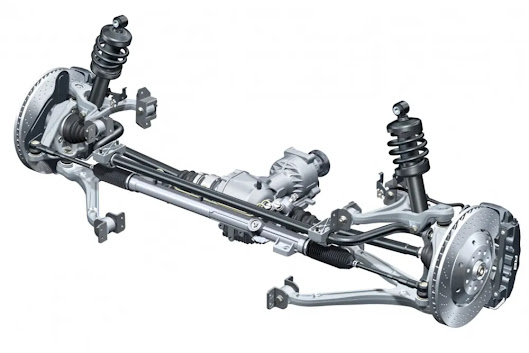The
suspension system is an essential part of an automobile, designed to enhance
the vehicle's handling, comfort, and overall performance. It is responsible for
connecting the vehicle to its wheels, ensuring a smooth and controlled ride
even on rough and uneven surfaces. This article delves into the function,
components, and types of suspension systems in automobiles.
Function
The primary
function of an automotive suspension system is to absorb the shocks and
vibrations produced by the vehicle's movement over different terrains. This is
crucial to maintain the comfort of the passengers and the stability of the car.
The suspension system also helps to:
1. Maintain
proper wheel alignment for better handling and reduced tire wear.
2. Support
the vehicle's weight and evenly distribute it across all four wheels.
3. Allow the
wheels to maintain contact with the road for optimal traction and braking
performance.
4. Minimize
body roll during cornering, providing a stable and controlled driving
experience.
Components
An
automotive suspension system is made up of several components that work
together to achieve these functions. These components include:
Springs
Springs are
the most fundamental part of a suspension system, responsible for cushioning
the vehicle's weight and absorbing the energy generated during vehicle
movement. They compress and expand to absorb the impact of road irregularities,
providing a smooth and comfortable ride. There are three types of springs used
in suspension systems:
1. Coil
Springs: These are the most common type of springs used in automotive
suspension systems. They consist of a long metal wire that is coiled into a
helical shape. Coil springs provide a good balance of comfort and handling and
are typically found in both front and rear suspensions.
2. Leaf
Springs: These are long, flat steel strips that are stacked together and
connected to the vehicle's frame at both ends. Leaf springs are typically used
in the rear suspension of trucks and heavy-duty vehicles due to their ability
to handle heavy loads.
3. Torsion
Bars: These long, straight metal bars twist when subjected to force. Torsion
bars are usually found in the front suspension of some vehicles and provide a
compact and lightweight alternative to coil springs.
Shock
Absorbers
Shock
absorbers, also known as dampers, help dissipate the energy absorbed by the
springs, controlling the vehicle's movement and preventing it from bouncing
excessively. They consist of a piston inside a cylinder filled with hydraulic
fluid or gas. When the vehicle encounters a bump or dip in the road, the piston
moves up and down within the cylinder, forcing the fluid or gas through small
openings. This action slows down the piston's movement, reducing the vibrations
felt by the vehicle's occupants.
Control
Arms
Control
arms, also known as A-arms or wishbones, are part of the suspension system that
connects the wheel hub and steering knuckle to the vehicle's frame. They assist
in maintaining proper wheel alignment and help control the motion of the
wheels. Control arms can be found in both the front and rear suspension systems
and are usually made of steel or aluminum.
Bushings
Bushings are
rubber or polyurethane components that are used to provide cushioning between
various suspension parts, reducing friction, noise, and vibrations. They are
typically found at the mounting points of control arms, sway bars, and other
suspension components.
Ball
Joints
Ball joints
are flexible connections that allow the control arms and steering knuckles to
move freely while maintaining their alignment. They consist of a ball-shaped
component inside a socket, allowing for a wide range of motion. Ball joints are
commonly found in the front suspension of vehicles and help ensure smooth
steering and handling.
Sway Bars
Sway bars,
also known as anti-roll bars or stabilizer bars, are metal rods that connect
the left and right wheels of a vehicle. They help minimize body roll during
cornering, providing a stable and controlled driving experience. Sway bars are
typically found in both front and rear suspension systems and can be adjusted
to fine-tune a vehicle's handling characteristics.
Types of Suspension
Systems
There are
several types of suspension systems used in automobiles, each with its own
advantages and disadvantages. The most common types include:
Independent
Suspension
Independent
suspension allows each wheel to move up and down independently of the other
wheels, providing better handling, traction, and comfort. This type of
suspension is typically found in modern cars and can be further classified
into:
1.
MacPherson Strut: This independent suspension type uses a single strut and
spring assembly to connect the wheel hub to the vehicle's frame. MacPherson
struts are commonly found in front-wheel-drive vehicles and are known for their
simplicity and cost-effectiveness.
2. Double
Wishbone: This independent suspension type uses two control arms to connect the
wheel hub to the vehicle's frame. Double wishbone suspension is commonly found
in high-performance cars and provides better handling and stability than
MacPherson struts.
Dependent
Suspension
Dependent
suspension connects the wheels on the same axle together, allowing them to move
up and down as a single unit. This type of suspension is typically found in
older cars and can be further classified into:
1. Solid
Axle: This type of dependent suspension uses a single axle to connect the
wheels. Solid axle suspension is known for its durability and simplicity but
can produce a rough and uncomfortable ride.
2. Twist
Beam: This is a type of dependent suspension that uses a beam that twists as
the wheels move up and down. Twist beam suspension is commonly found in small
cars and provides better handling and comfort than solid axle suspension.
Conclusion
The
suspension system is an essential part of an automobile, responsible for providing
a smooth and controlled ride while maintaining the vehicle's handling and
stability. Understanding the function and components of the suspension system
can help drivers better appreciate the importance of this system and make
informed decisions when it comes to maintaining or upgrading their vehicle's
suspension.



Comments
Post a Comment
Your opinion matters to us, if you have any questions, write it in a comment